Microstructure and Air Trace Defects of the Rapidly Solidified ZK60 Magnesium Alloy Ribbon
Abstract
1. Introduction
2. Experimental Procedure
3. Result and Discussion
3.1. Solidification Rate Calculation
3.2. The Gas Trace Morphology of the Ribbon at the Different Speeds of the Roller
3.3. Microstructure of ZK60 Alloy with the Different Speeds of the Molybdenum Roller
3.4. Characterization of ZK60 Alloy with the Different Speeds of the Molybdenum Roller
4. Conclusions
- Under a carbon dioxide atmosphere, when the online speed is 17.6 m/s, the ZK60 ribbon gas trace ratio is at least 15.64%;
- With the increase in solidification rate, the base texture of the ribbon is enhanced, and the proportion of columnar crystal in the ZK60 ribbon gradually increases until it penetrates through the ribbon;
- A quasicrystalline phase appears in the rapidly solidified ZK60 ribbon. The 17.6 m/s ribbon quasicrystalline phase is spherical and evenly distributed in the magnesium matrix, and all parts of the strip have a uniform microstructure and mechanical properties.
Author Contributions
Funding
Institutional Review Board Statement
Informed Consent Statement
Data Availability Statement
Conflicts of Interest
References
- Cohen, M.; Kear, B.H.; Mehrabian, R. Rapid Solidification Processing Principles and Technologies: Proceeding; Claitor’s Publishing Division: Baton Rouge, LA, USA, 1978. [Google Scholar]
- Trivedi, R.; Kurz, W. Dendritic growth. Int. Mater. Rev. 1994, 39, 49–74. [Google Scholar] [CrossRef]
- Duwez, P.; Willens, R.H.; Klement, W., Jr. Metastable Solid Solutions in the Gallium Antimonide-Germanium Pseudobinary System. J. Appl. Phys. 1960, 31, 1500. [Google Scholar] [CrossRef]
- Klement, W.; Willens, R.H.; Duwez, P.O.L. Non-crystalline structure in solidified gold–silicon alloys. Nature 1960, 187, 869–870. [Google Scholar] [CrossRef]
- Nishimoto, S.; Yamasaki, M.; Kawamura, Y. Inherited multimodal microstructure evolution of high-fracture-toughness Mg-Zn-Y-Al alloys during extrusion for the consolidation of rapidly solidified ribbons. J. Magnes. Alloys 2022, 10, 2433–2445. [Google Scholar] [CrossRef]
- Martucci, A.; Aversa, A.; Lombardi, M. Ongoing challenges of laser-based powder bed fusion processing of Al alloys and potential solutions from the literature—A review. Materials 2023, 16, 1084. [Google Scholar] [CrossRef] [PubMed]
- Najafizadeh, N.; Chu, M.G.; Gu, Y. Selection of solidification pathway in rapid solidification processes. Phys. Rev. Mater. 2023, 7, 023403. [Google Scholar] [CrossRef]
- Karaköse, E.; Çolak, H. Effect of cooling rate and Mg addition on the structural evaluation of rapidly solidified Al-20wt% Cu-12wt% Fe alloy. Mater. Charact. 2016, 121, 68–75. [Google Scholar] [CrossRef]
- Guo, Y.; Quan, G.; Jiang, Y.; Ren, L.; Fan, L.; Pan, H. Formability, microstructure evolution and mechanical properties of wire arc additively manufactured AZ80M magnesium alloy using gas tungsten arc welding. J. Magnes. Alloys 2021, 9, 192–201. [Google Scholar] [CrossRef]
- Wang, B.; Liu, Y.; An, J.; Li, R.; Su, Z.; Su, G.; Lu, Y.; Cao, Z. Evolution of the microstructure and hardness of a rapidly solidified/melt-spun AZ91 alloy upon aging at different temperatures. Mater. Charact. 2009, 60, 316–321. [Google Scholar] [CrossRef]
- Froes, F.H.; Kim, Y.-W.; Krishnamurthy, S. Rapid solidification of lightweight metal alloys. Mater. Sci. Eng. A 1989, 117, 19–32. [Google Scholar] [CrossRef]
- Zhang, H.J.; Zhang, D.F.; Ma, C.H.; Guo, S.F. Improving mechanical properties and corrosion resistance of Mg–6Zn–Mn magnesium alloy by rapid solidification. Mater. Lett. 2013, 92, 45–48. [Google Scholar] [CrossRef]
- Shahri, F.; Beitollahi, A. Effect of super-heat treatment and quenching wheel speed on the structure and magnetic properties of Fe–Si–Nb–Cu–B–Al–Ge melt spun ribbons. J. Non-Cryst. Solids 2008, 354, 1487–1493. [Google Scholar] [CrossRef]
- Lavernia, E.J.; Srivatsan, T.S. The rapid solidification processing of materials: Science, principles, technology, advances, and applications. J. Mater. Sci. 2010, 45, 287–325. [Google Scholar] [CrossRef]
- Keyvanara, A.; Gholamipour, R.; Mirdamadi, S.; Shahri, F.; Salavati-Fard, T.; Abdolhoseini, A. Effect of quenching wheel speed on the structure, magnetic properties and magnetoimpedance effect in Co64Fe4Ni2B19−xSi8Cr3Alx (x = 0, 1 and 2) melt-spun ribbons. J. Magn. Magn. Mater. 2010, 322, 2680–2683. [Google Scholar] [CrossRef]
- Zhou, T.; Chen, Z.; Yang, M.; Hu, J.; Xia, H. Investigation on microstructure characterization and property of rapidly solidified Mg–Zn–Ca–Ce–La alloys. Mater. Charact. 2012, 63, 77–82. [Google Scholar] [CrossRef]
- Nair, K.S.; Mittal, M.C.; Lal, K.; Mahanti, R.K.; Sivaramakrishnan, C.S. Development of rapidly solidified (RS) magnesium–aluminium–zinc alloy. Mater. Sci. Eng. A 2001, 304, 520–523. [Google Scholar]
- Izumi, S.; Yamasaki, M.; Kawamura, Y. Relation between corrosion behavior and microstructure of Mg–Zn–Y alloys prepared by rapid solidification at various cooling rates. Corros. Sci. 2009, 51, 395–402. [Google Scholar] [CrossRef]
- Garcés, G.; Requena, G.; Tolnai, D.; Pérez, P.; Medina, J.; Stark, A.; Schell, N.; Adeva, P. Formation of an 18R long-period stacking ordered structure in rapidly solidified Mg88Y8Zn4 alloy. Mater. Charact. 2016, 118, 514–518. [Google Scholar] [CrossRef]
- Šustek, V.; Spigarelli, S.; Čadek, J. Creep behaviour at high stresses of a Mg-Zn-Ca-Ce-La alloy processed by rapid solidification. Scr. Mater. 1996, 35, 449–454. [Google Scholar] [CrossRef]
- Čadek, J.; Šustek, V.; Kloc, L.; Evangelista, E. Threshold creep behaviour of an MgZnCaCeLa alloy processed by rapid solidification. Mater. Sci. Eng. A 1996, 215, 73–83. [Google Scholar] [CrossRef]
- Kawamura, Y.; Yamagata, H.; Inoue, S.-i.; Kiguchi, T.; Chattopadhyay, K. Kink bands and strengthening of millefeuille-structured magnesium alloys by cluster-arranged nanoplates (CANaPs): The case of Mg-0.4 Zn-1.0 Y alloy. J. Alloys Compd. 2023, 939, 168607. [Google Scholar] [CrossRef]
- Karaköse, E.; Colak, H.; Keskin, M. The Effect of Magnesium Additions on Microstructural, Thermal, and Mechanical Properties of Rapidly Solidified Al-5.5 wt.% Zn-x wt.% Mg (x = 1, 5) Alloys. J. Mater. Eng. Perform. 2020, 29, 7308–7320. [Google Scholar] [CrossRef]
- Zhang, J.; Wang, F.; Wen, X.; Cheng, F. Melting process and melt structure of fly ash/magnesium slag blends for the production of inorganic fibers. Ceram. Int. 2021, 47, 21023. [Google Scholar] [CrossRef]
- Cantor, B.; Kim, W.T.; Bewlay, B.P.; Gillen, A.G. Microstructure—Cooling rate correlations in melt-spun alloys. J. Mater. Sci. 1991, 26, 1266–1276. [Google Scholar] [CrossRef]
- Yu, Z.H.; Yan, H.G.; Gong, X.S.; Quan, Y.J.; Chen, J.H.; Chen, Q. Microstructure and mechanical properties of laser welded wrought ZK21 magnesium alloy. Mater. Sci. Eng. A 2009, 523, 220–225. [Google Scholar] [CrossRef]
- Santos, F.S.; Sort, J.; Fornell, J.; Baró, M.D.; Suriñach, S.; Bolfarini, C.; Botta, W.J.; Kiminami, C.S. Mechanical behavior under nanoindentation of a new Ni-based glassy alloy produced by melt-spinning and copper mold casting. J. Non-Cryst. Solids 2010, 356, 2251–2257. [Google Scholar] [CrossRef]
- Oliver, W.C.; Pharr, G.M. An improved technique for determining hardness and elastic modulus using load and displacement sensing indentation experiments. J. Mater. Res. 1992, 7, 1564–1583. [Google Scholar] [CrossRef]
- Xu, C.L.; Wang, H.Y.; Qiu, F.; Yang, Y.F.; Jiang, Q.C. Cooling rate and microstructure of rapidly solidified Al–20 wt.% Si alloy. Mater. Sci. Eng. A 2006, 417, 275–280. [Google Scholar] [CrossRef]
- Wang, X.J.; Chen, X.D.; Xia, T.D.; Yu, W.Y.; Wang, X.L. Influencing factors and estimation of the cooling rate within an amorphous ribbon. Intermetallics 2004, 12, 1233–1237. [Google Scholar] [CrossRef]
- Sauthoff, G. Intermetallics; John Wiley & Sons: Hoboken, NJ, USA, 2008. [Google Scholar]
- Liang, Y.J.; Che, M.C.; Liu, X.X. Thermodynamics Handbook of Mineral; Northeast University Press: Shenyang, China, 1994. [Google Scholar]
- Hahn, D.W.; Özisik, M.N. Heat Conduction; John Wiley & Sons: Hoboken, NJ, USA, 2012. [Google Scholar]
- Napolitano, R.E.; Meco, H. The role of melt pool behavior in free-jet melt spinning. Metall. Mater. Trans. A 2004, 35, 1539–1553. [Google Scholar] [CrossRef][Green Version]
- Zhang, S.-Y.; Wang, X.; Liu, X.; Mo, Y.-T.; Wang, C.; Cheng, T.; Ivasishin, O.; Wang, H.-Y. High strength-ductility synergy induced by sub-rapid solidification in twin-roll cast Al–Mg–Si alloys. J. Mater. Res. Technol. 2022, 16, 922–933. [Google Scholar] [CrossRef]
- Shuai, C.; Zhao, Y.; Li, C.; Deng, Y.; Zhao, Z.; Gao, C. Supersaturated solid solution enhanced biodegradable Zn-Mn alloys prepared by mechanical alloying and selective laser melting. J. Alloys Compd. 2023, 943, 169145. [Google Scholar] [CrossRef]
- Ōno, A. Metal Coagulation; Guangxi People’s Publishing House: Guangxi, China, 1983. [Google Scholar]
- Sun, M.; Wu, G.; Wang, W.; Ding, W. Effect of Zr on the microstructure, mechanical properties and corrosion resistance of Mg–10Gd–3Y magnesium alloy. Mater. Sci. Eng. A 2009, 523, 145–151. [Google Scholar] [CrossRef]
- Qian, M.; StJohn, D.H.; Frost, M.T. Characteristic zirconium-rich coring structures in Mg–Zr alloys. Scr. Mater. 2002, 46, 649–654. [Google Scholar] [CrossRef]
- Huo, M.; Liu, L.; Yang, W.; Li, Y.; Hu, S.; Su, H.; Zhang, J.; Fu, H. Formation of low-angle grain boundaries under different solidification conditions in the rejoined platforms of Ni-based single crystal superalloys. J. Mater. Res. 2019, 34, 251–260. [Google Scholar] [CrossRef]
- Liu, Q.; Fang, L.; Xiong, Z.; Yang, J.; Tan, Y.; Liu, Y.; Zhang, Y.; Tan, Q.; Hao, C.; Cao, L. The response of dislocations, low angle grain boundaries and high angle grain boundaries at high strain rates. Mater. Sci. Eng. A 2021, 822, 141704. [Google Scholar] [CrossRef]
- Mordike, B.L.; Riehemann, W. Mechanical properties and thermal stability of rapidly solidified magnesium alloys. Key Eng. Mater. 1995, 97, 13–28. [Google Scholar] [CrossRef]
- Schurack, F.; Eckert, J.; Schultz, L. Synthesis and mechanical properties of cast quasicrystal-reinforced Al-alloys. Acta Mater. 2001, 49, 1351–1361. [Google Scholar] [CrossRef]
- Inoue, A.; Kimura, H. Fabrications and mechanical properties of bulk amorphous, nanocrystalline, nanoquasicrystalline alloys in aluminum-based system. J. Light Met. 2001, 1, 31–41. [Google Scholar] [CrossRef]
- Dubois, J.-M. Bulk and surface properties of quasicrystalline materials and their potential applications. In Quasicrystals: An Introduction to Structure, Physical Properties and Applications; Springer: Berlin/Heidelberg, Germany, 2002; pp. 507–538. [Google Scholar]
- Fischer-Cripps, A.C.; Fischer-Cripps, A.C. Factors affecting nanoindentation test data. In Nanoindentation; Springer: New York, NY, USA, 2011; pp. 77–104. [Google Scholar]
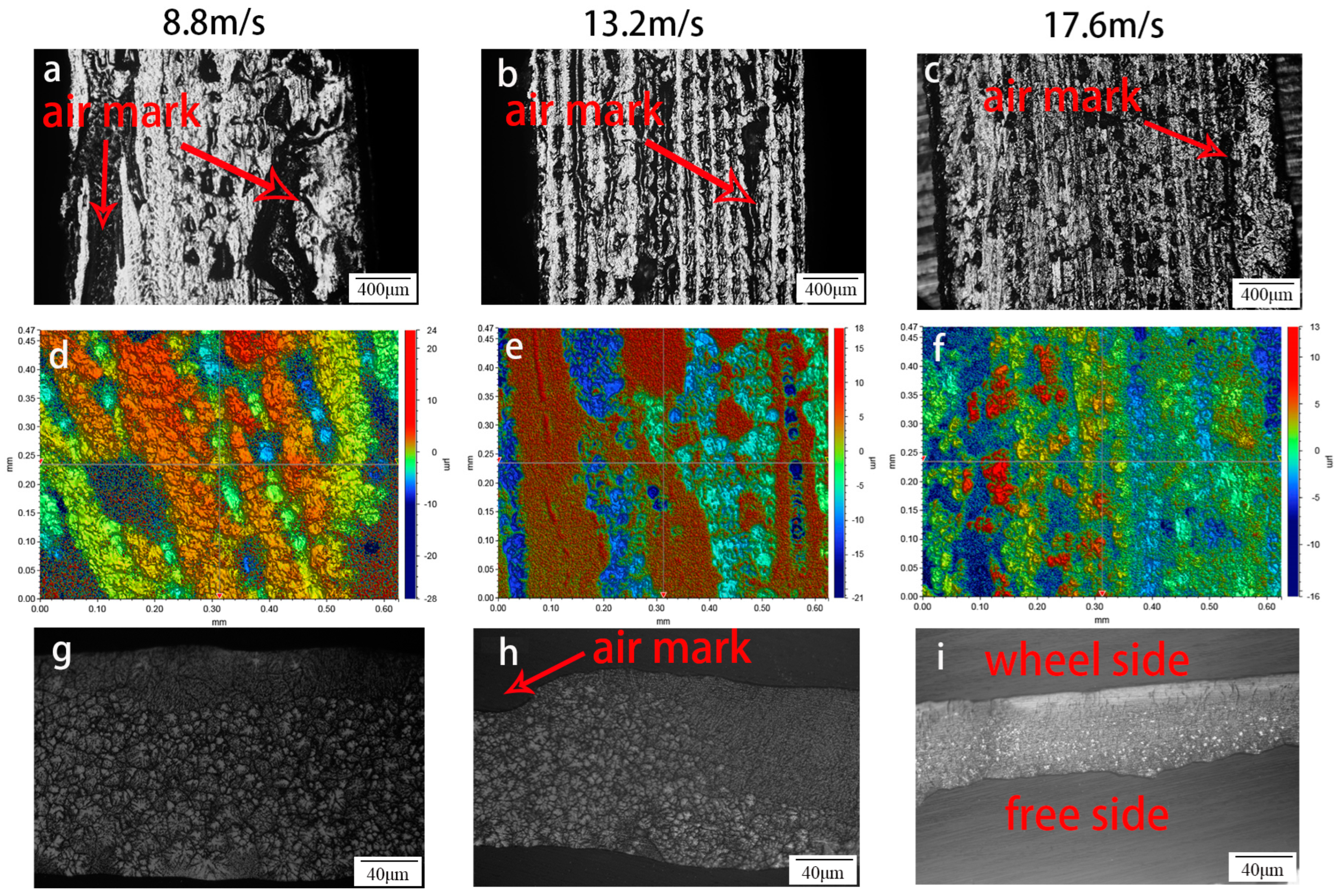

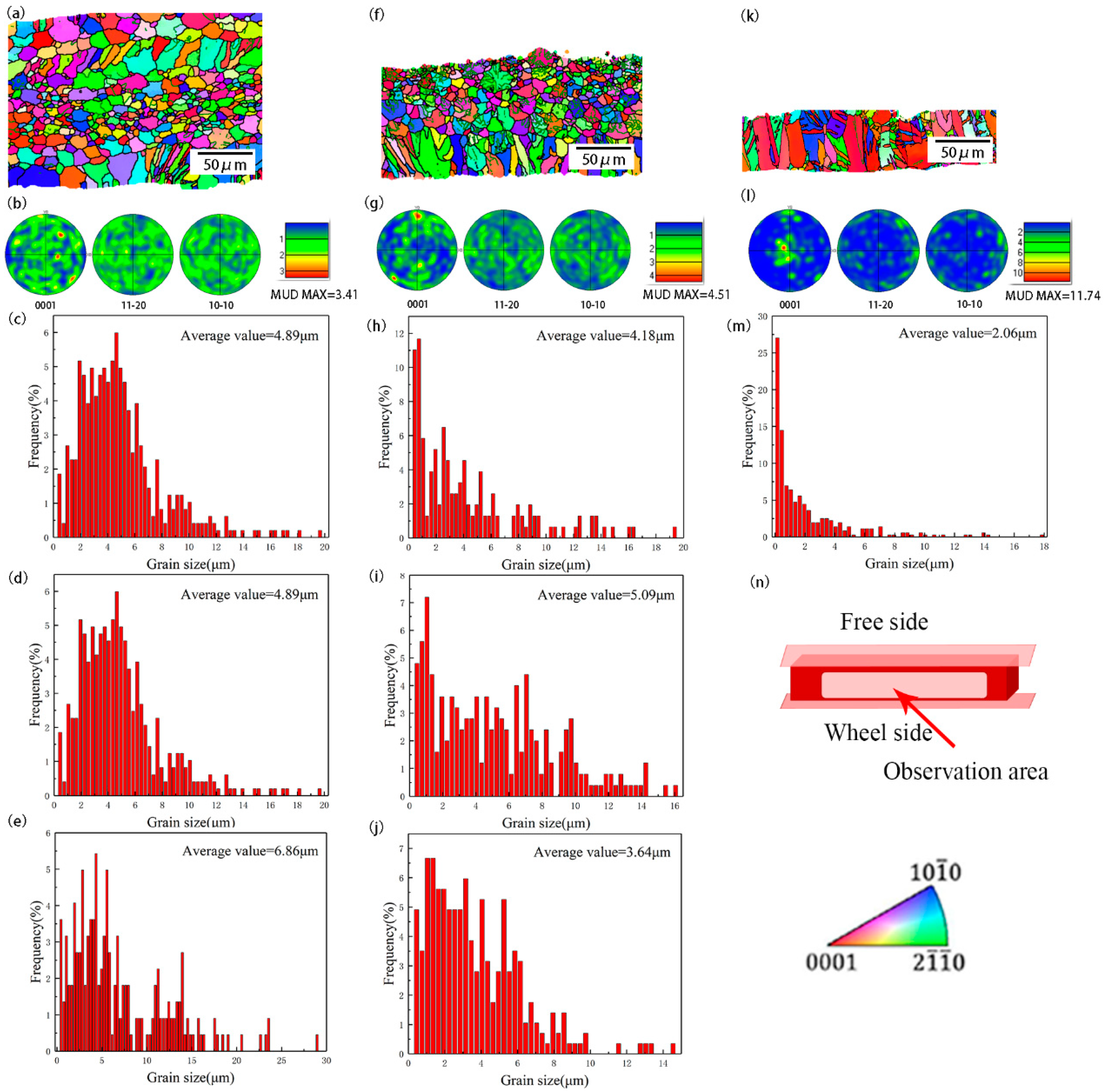

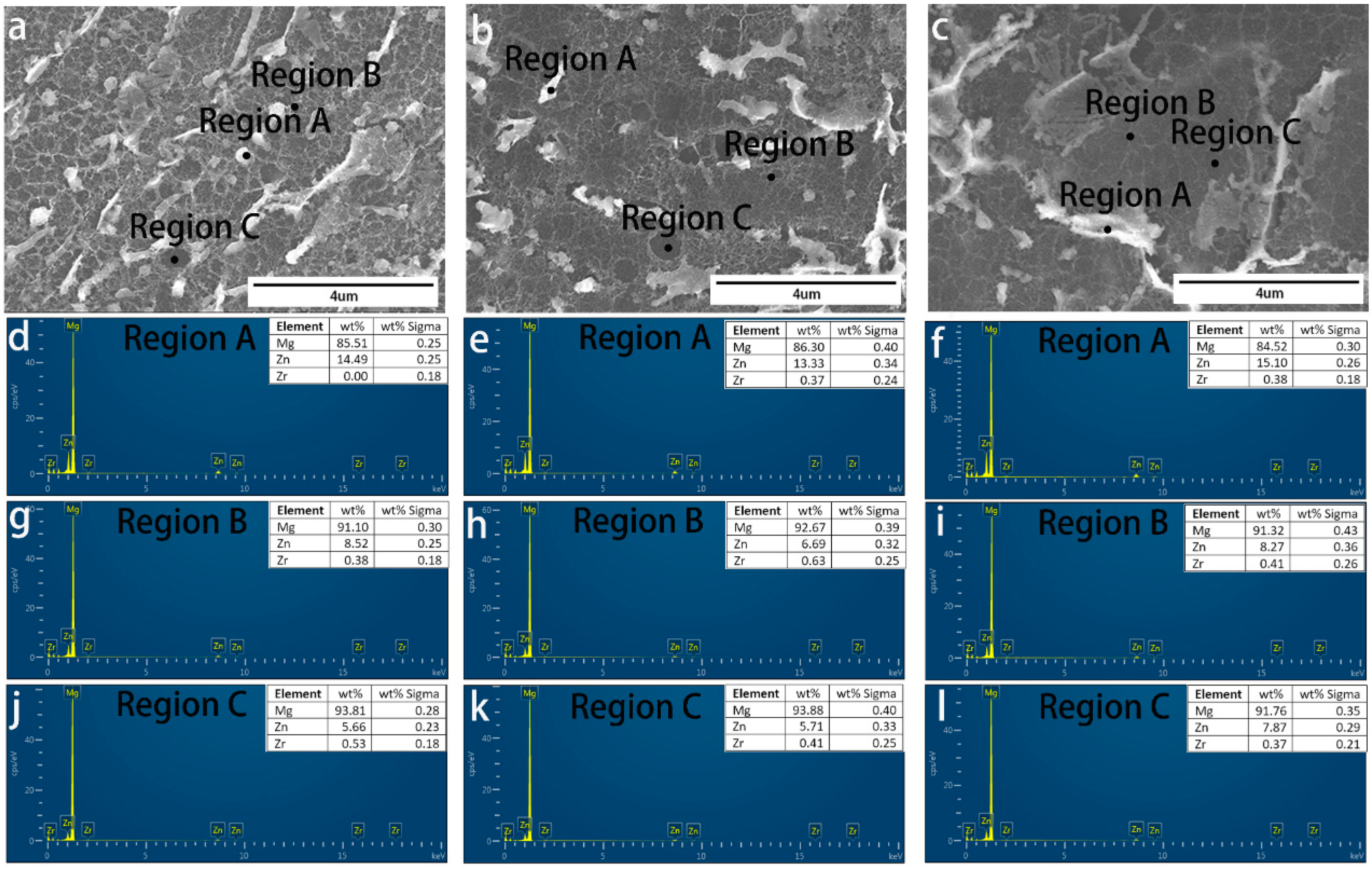

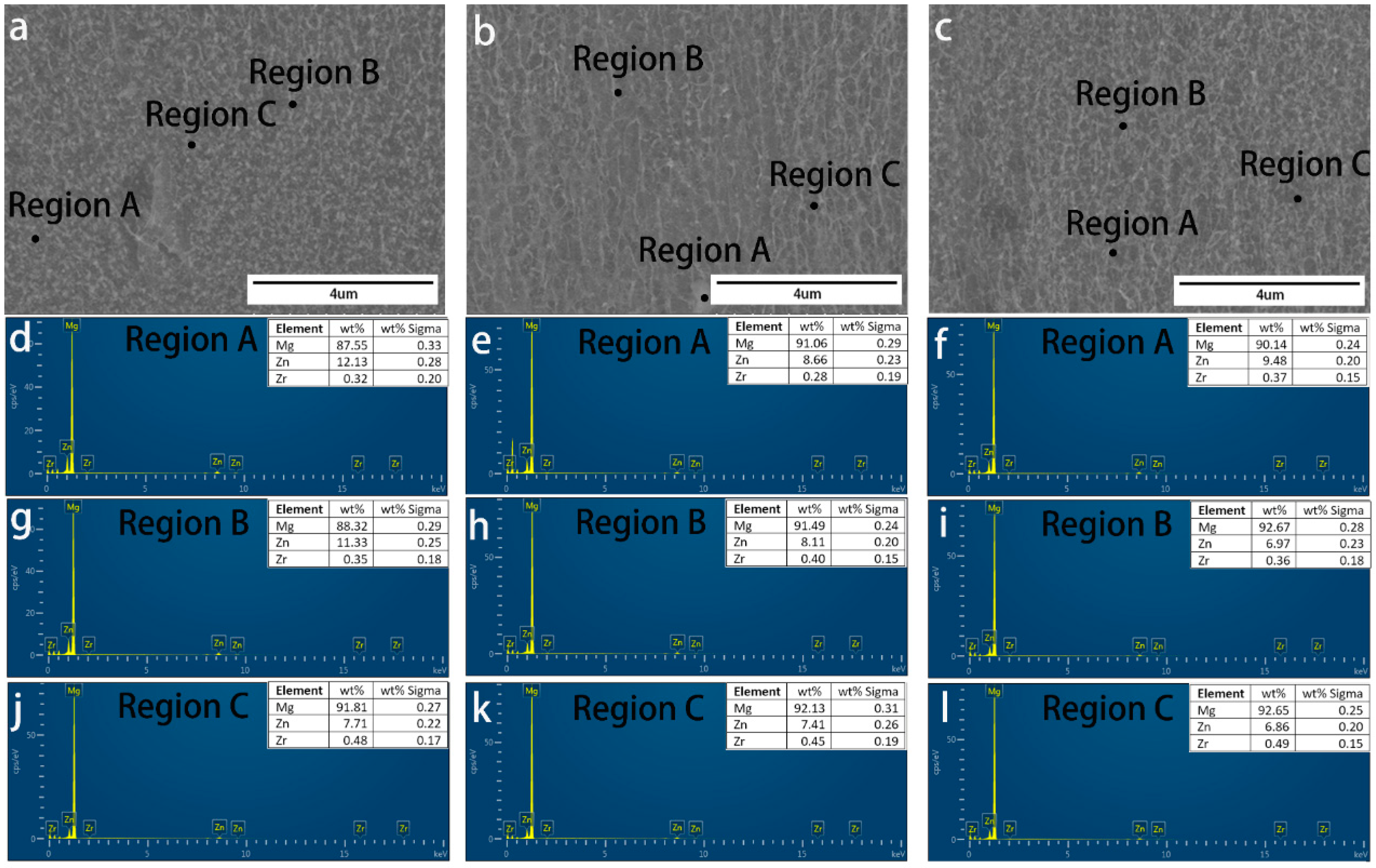
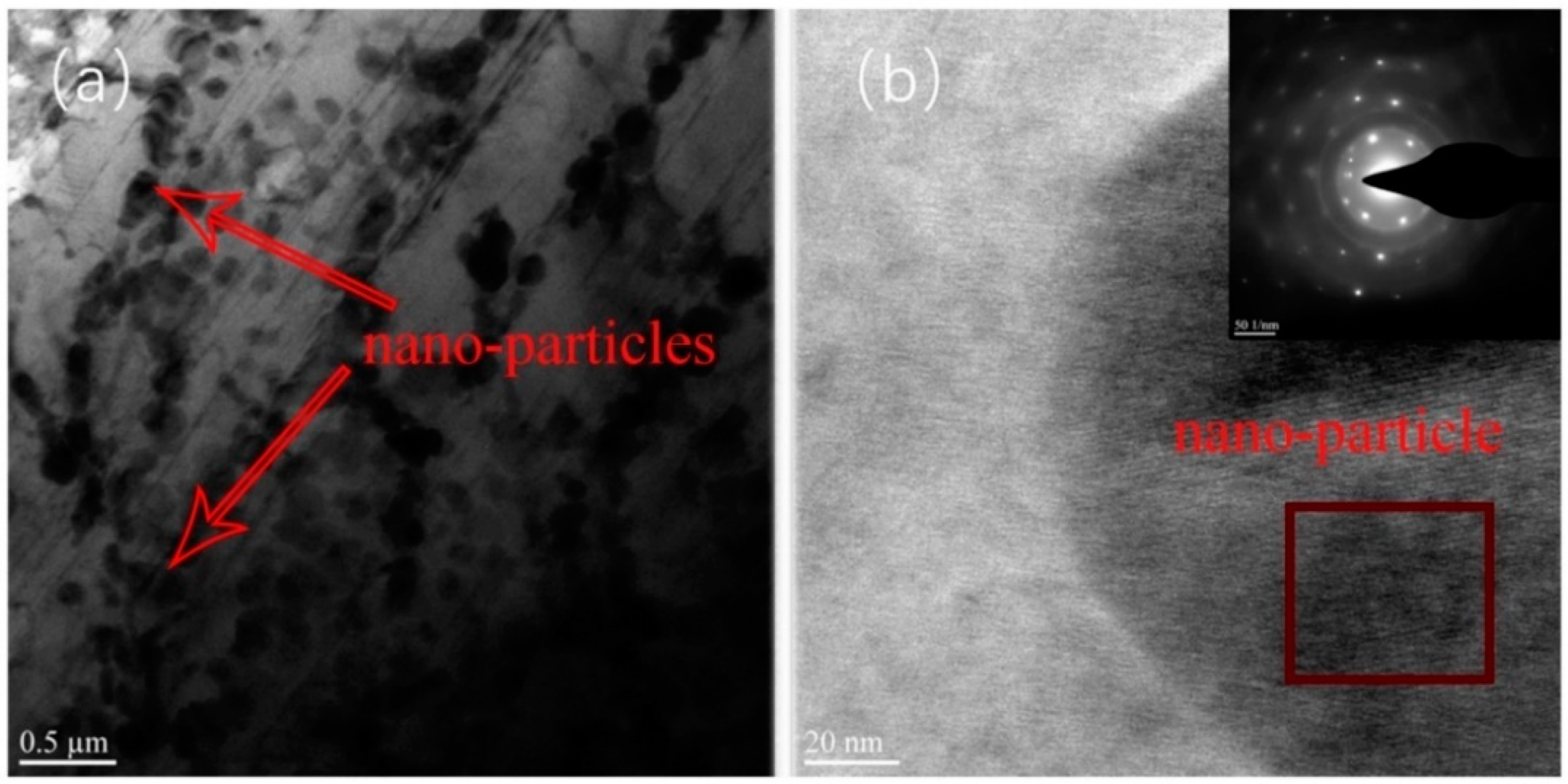

| Parament | ZK60 | Mo |
|---|---|---|
| Initial temperature T0 (K) | 1053 (T10) | 300 (T20) |
| Thermal conductivity k (W/(m B K)) | 83.71 (k1) | 147 (k2) |
| Specific heat capacity, c (J/(kg B K)) | 1360 (c1) | 273.35 (c2) |
| Density, ρ (kg/m3) | 1650 (ρ1) | 10,200 (ρ2) |
| Latent heat L (kJ/kg) | 290.93 |
| Sample | hMax (nm) | H (GPa) |
|---|---|---|
| W1 | 1038.8 | 0.89 |
| C1 | 1231.8 | 0.58 |
| F1 | 1060.1 | 0.78 |
| W2 | 1015 | 0.9 |
| C2 | 1271 | 0.58 |
| F2 | 1086.1 | 0.72 |
| W3 | 856 | 1.23 |
| C3 | 920 | 1.06 |
| F3 | 876 | 1.17 |
| Sample | (nm × mN) | S1 | (nm × mN) | S2 |
|---|---|---|---|---|
| W1 | 6410.632173 | 561.4917 | 2339.953 | 377.8114 |
| C1 | 7320.175548 | 1775.382 | ||
| F1 | 7758.867019 | 1422.623 | ||
| W2 | 6127.431315 | 299.612 | 2465.272 | 113.3588 |
| C2 | 6424.778697 | 2284.148 | ||
| F2 | 6857.174349 | 2192.442 | ||
| W3 | 5710.625292 | 251.4887 | 1195.444 | 7.108149 |
| C3 | 5491.70318 | 1198.968 | ||
| F3 | 5102.501641 | 1211.972 |
Disclaimer/Publisher’s Note: The statements, opinions and data contained in all publications are solely those of the individual author(s) and contributor(s) and not of MDPI and/or the editor(s). MDPI and/or the editor(s) disclaim responsibility for any injury to people or property resulting from any ideas, methods, instructions or products referred to in the content. |
© 2023 by the authors. Licensee MDPI, Basel, Switzerland. This article is an open access article distributed under the terms and conditions of the Creative Commons Attribution (CC BY) license (https://creativecommons.org/licenses/by/4.0/).
Share and Cite
Bao, S.; Yang, C.; Li, Z.; Ye, P.; Chen, Y. Microstructure and Air Trace Defects of the Rapidly Solidified ZK60 Magnesium Alloy Ribbon. Materials 2024, 17, 30. https://doi.org/10.3390/ma17010030
Bao S, Yang C, Li Z, Ye P, Chen Y. Microstructure and Air Trace Defects of the Rapidly Solidified ZK60 Magnesium Alloy Ribbon. Materials. 2024; 17(1):30. https://doi.org/10.3390/ma17010030
Chicago/Turabian StyleBao, Shuai, Chao Yang, Zhenshuai Li, Peiran Ye, and Yungui Chen. 2024. "Microstructure and Air Trace Defects of the Rapidly Solidified ZK60 Magnesium Alloy Ribbon" Materials 17, no. 1: 30. https://doi.org/10.3390/ma17010030
APA StyleBao, S., Yang, C., Li, Z., Ye, P., & Chen, Y. (2024). Microstructure and Air Trace Defects of the Rapidly Solidified ZK60 Magnesium Alloy Ribbon. Materials, 17(1), 30. https://doi.org/10.3390/ma17010030





